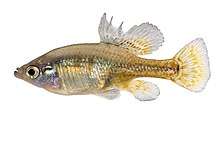Golden skiffia
Skiffia francesae, the golden skiffia or tiro dorado,[2] is a species of splitfin endemic to the Rio Teuchitlán, a tributary of Río Ameca in western Mexico.[3] It is extinct in the wild,[1] but has been maintained in aquaria and the aquarium hobbyist trade.[4]
| Golden skiffia | |
|---|---|
 | |
| Scientific classification | |
| Kingdom: | Animalia |
| Phylum: | Chordata |
| Class: | Actinopterygii |
| Order: | Cyprinodontiformes |
| Family: | Goodeidae |
| Genus: | Skiffia |
| Species: | S. francesae |
| Binomial name | |
| Skiffia francesae Kingston, 1978 | |
Taxonomy and etymology
The scientific name of the golden skiffia is Skiffia francesae. It is a member of the family Goodeidae, a small but diverse group restricted to Mexico. This species was first described in the journal Copeia by Dolores Kingston, from preserved and live specimens in the University of Michigan Museum of Zoology. This species was named in honor of Frances H. Miller who, along with her husband Robert Rush Miller, helped to collect and ship the live specimens.[3]
Description
The golden skiffia is a small fish, reaching a maximum standard length (SL) of around 4.3 cm (1.7 in), with a wedge shaped head and upturned lips. It has of a row 30–35 deeply cleft outer teeth in both the upper and lower jaws. Inner teeth can be cleft or conical, and are scattered irregularly. The species shows sexual dimorphism with males having larger fins, and a greater body and head depth. Males also have a notched dorsal fin, which females lack. Males are a bright gold color with a gray overcast. The gold coloration is most vibrant during courtship, largely fading to the dorsal, caudal, and anal fins in non-courting males. Females have a greater body width, and both females and juveniles are gray-green, with scattered black flecks on their backs and along the lateral line. Females do not change color during courtship. Both sexes have a black crescent just before the tail fin.[3]
Life cycle
Golden skiffia is ovoviviparous, giving birth to live young rather than laying eggs. The right and left ovaries are merged into a single organ, in which the young are gestated. This organ is capable of enlarging as the young develop. While in the ovary, the young possess trophotaenia. Each trophotaenia has three lobes containing blood vessels, which are believed to function in nutrient and gas exchange. Newborn young lose their trophotaenia shortly after birth.[3] The gestation period is 55–60 days, with a usual brood size of 10–15 young.[5]
Ecology
Range and habitat
Golden skiffia has been declared extinct in the wild. Prior to extirpation, it was found in the Rio Teuchitlán, a tributary of the Río Ameca in Jalisco state, Mexico. The area of the river inhabited by golden skiffia had a slight current, with murky water and mud, sand, and silt substrate. Golden skiffia occurred at a maximum depth of 0.5 m (1.6 ft). At the time specimens were collected, shore vegetation was dominated by Acacia and Salix, while aquatic vegetation included Pistia, Ceratophyllum, Potamogeton, and water hyacinth. The shore suffers from heavy human encroachment, and the water is polluted. In 1976, an aquarium variety of platyfish, Xiphophorus maculatus was found. This introduced species was found to outnumber Golden skiffia by a factor of 50. Golden skiffia's numbers were dramatically reduced within a year, likely due to competition from X. maculatus.[3]
Golden skiffia is likely a benthic feeder, as indicated by gut contents dominated by pennate diatoms.[3]
References
- Koeck, M. (2019). "Skiffia francesae". IUCN Red List of Threatened Species. 2019: e.T20285A2757376. doi:10.2305/IUCN.UK.2019-2.RLTS.T20285A2757376.en.
- "Skiffia francesae". Integrated Taxonomic Information System. 17 December 2016.
- Kingston, Dolores Irene (10 August 1978). "Skiffia francesae, a New Species of Goodeid Fish from Western Mexico". Copeia. 1978 (3): 503–508. doi:10.2307/1443618. JSTOR 1443618.
- De La Vega-Salazar, Marina; Avila-Luna, Edgar; Macías-Garcia, Constantino (2003). "Ecological evaluation of local extinction: the case of two genera of endemic Mexican fish, Zoogoneticus and Skiffia". Biodiversity & Conservation. 12 (10): 2043–2056. doi:10.1023/A:1024155731112.
- Froese, Rainer and Pauly, Daniel, eds. (20166). "Skiffia francesae" in FishBase. 10 20166 version.
